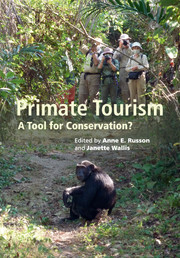Book contents
- Frontmatter
- Contents
- List of contributors
- Part I Introduction
- Part II Asian primates
- Part III African primates
- 7 Lemurs and tourism in Ranomafana National Park, Madagascar
- 8 Some pathogenic consequences of tourism for nonhuman primates
- 9 Baboon ecotourism in the larger context
- 10 Mountain gorilla tourism as a conservation tool
- 11 Evaluating the effectiveness of chimpanzee tourism
- Part IV Neotropical primates
- Part V Broader issues
- Part VI Conclusion
- Index
- References
10 - Mountain gorilla tourism as a conservation tool
Have we tipped the balance?
from Part III - African primates
Published online by Cambridge University Press: 05 September 2014
- Frontmatter
- Contents
- List of contributors
- Part I Introduction
- Part II Asian primates
- Part III African primates
- 7 Lemurs and tourism in Ranomafana National Park, Madagascar
- 8 Some pathogenic consequences of tourism for nonhuman primates
- 9 Baboon ecotourism in the larger context
- 10 Mountain gorilla tourism as a conservation tool
- 11 Evaluating the effectiveness of chimpanzee tourism
- Part IV Neotropical primates
- Part V Broader issues
- Part VI Conclusion
- Index
- References
Summary
Introduction
The importance of gorilla conservation was recognized early, when the first National Park in Africa was established in 1925. This park, now known as the Virunga National Park, was created primarily to protect the mountain gorilla (Gorilla beringei beringei). Population estimates by George Schaller in 1960 averaged between 400 and 500 individuals (Schaller, 1963), but by 1978 only 252–285 remained (Weber & Vedder, 1983). Although the park did offer some protection, instability in the area along with poaching and habitat encroachment continued to threaten the gorilla population. Attempting to stem the decline, The Mountain Gorilla Project (now known as the International Gorilla Conservation Program – IGCP) was launched in 1979 with tourism as one of its main goals.
Gorilla tourism initiatives in areas of high threat started by converting poachers into rangers, to demonstrate that living gorillas were worth more than the price of a hand, foot, or head. For shifting this view of gorillas and getting governments on board, gorilla tourism is credited with saving this endangered species from possible extinction (Harcourt, 1986; McNeilage, 1996; Sholley, 1991; Stewart, 1991; Vedder & Weber, 1990; Weber, 1993; Williamson, 2001). Along with this success, however, came unforeseen costs and recently, some researchers have taken a more critical look at the short- and long-term consequences of gorilla tourism as a conservation tool (e.g. Butynski & Kalina, 1998; Frothmann et al., 1996; Goldsmith, 2005; Homsy, 1999).
- Type
- Chapter
- Information
- Primate TourismA Tool for Conservation?, pp. 177 - 198Publisher: Cambridge University PressPrint publication year: 2014
References
- 11
- Cited by



